Montreal Expos
| Montreal Expos |
|---|
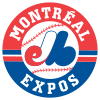 |
| Established: 1969 (Expansion team) |
| Relocated: December 3, 2004 (to Washington, D.C., as the Washington Nationals) |
| Major league affiliations: *National League (1969–2004) **East Division (1969–2004) |
| Stadium:
Jarry Park Stadium, Montreal (1969–1976) |
| Uniform Colors: Blue, White, Red
|
| Logo Design: A stylized "M" for Montreal, containing a red "e" for Expos, and a blue "b" for baseball.[1] |
| Mascot: Souki (1978), Youppi (1979–2004)[2] |
| Theme Song: Les Expos sont là ("The Expos are here") by Marc Gélinas |
| Division Championships:[*] 1981 |
| National League Championships: None |
| World Series Championships: None |
| [*] In 1981, a players' strike in the middle of the season forced the season to be split into two halves. Montreal won the division in the second half, despite having the second best record in the division when considering the entire season, two games behind St. Louis. In 1994, a players' strike wiped out the last eight weeks of the season and all post-season. Montreal was in first place by six games in the National League East Division when play was stopped. No official titles were awarded in 1994. |
| Geographical Rivals: New York Mets, Philadelphia Phillies, Toronto Blue Jays (interleague play) |
The Montreal Expos (French: Les Expos de Montréal) were a Major League Baseball team located in Montreal, Quebec, Canada from 1969 until the end of the 2004 season, when the team was moved to Washington, D.C. and became the Washington Nationals.
Named after the Expo 67 World's Fair, the Expos started play at Jarry Park under manager Gene Mauch. The team's initial majority owner was Charles Bronfman, a major shareholder in Seagram. Following the 1976 Summer Olympics, starting in 1977 the team's home venue was Montreal's Olympic Stadium. After a decade of losing seasons, the team won a franchise-high 95 games in 1979, finishing second in the National League East. The Expos began the 1980s with a core group of young players, including catcher Gary Carter, outfielders Tim Raines and Andre Dawson, third baseman Tim Wallach, and pitchers Steve Rogers and Bill Gullickson. The team won its only division championship in the strike-shortened split season of 1981, ending its season with a 3 games to 2 loss to the Los Angeles Dodgers in the National League Championship Series.
After a number of up-and-down seasons, the team was sold to a consortium of owners in 1991, with Claude Brochu as the managing general partner.[3] Buck Rodgers, manager since the 1985 season and, at that time, second only to Gene Mauch in number of Expos games managed, was replaced early in the 1991 season. In May 1992, Felipe Alou, a long time member of the Expos organization since 1976, was promoted to field manager, becoming the first Dominican-born manager in MLB history.[3] Alou would become the leader in Expos games managed while guiding the team to winning records, including 1994, when the Expos, led by a talented group of players including Larry Walker, Moisés Alou, Marquis Grissom and Pedro Martínez, had the best record in the major leagues until the strike forced the cancellation of the remainder of the season. After the disappointment of 1994, Expos management began shedding its key players, and the team's fan support dwindled. Brochu sold control of the team to Jeffrey Loria in 1999,[4][5] but Loria failed to close on a plan to build a new downtown ballpark, and did not reach an agreement on television and English radio broadcast contracts for the 2000 season, reducing the team's media coverage.
In November 2001, MLB's owners voted 28–2 to contract MLB by two teams—according to various sources, the Expos and the Minnesota Twins, both of which reportedly voted against contraction.[6] Subsequently, the Boston Red Sox were sold to a partnership led by John W. Henry, owner of the Florida Marlins.[6][7] To clear the way for Henry's group to assume ownership of the Red Sox, Henry sold the Marlins to Loria, and MLB purchased the Expos from Loria.[6] However, as the Metropolitan Sports Facilities Commission, operator of Minnesota's Metrodome, won an injunction requiring the Twins to play there in 2002,[6] MLB was unable to revoke the Twins franchise, and so had to keep both the Twins and Expos as part of the MLB schedule. In the collective bargaining agreement signed with the players association in August 2002, contraction was prohibited through to the end of the contract in 2006.[8] On September 29, 2004, the date of Montreal's last home game of the season, MLB announced that the Montreal franchise would move to Washington, D.C. for the 2005 season.[9] The Expos played their final game on October 3, 2004 at Shea Stadium, losing by a score of 8–1 against the New York Mets, the same opponent that the Expos first faced at its start, 35 years earlier. The Washington team was named the Washington Nationals, and retained all the Expos' records, player contracts, and minor league affiliates, as well as their spring training complex in Viera, Florida.
Contents |
Franchise history
Creation of the franchise
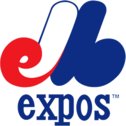
In 1960, Montreal lost its International League team, the Montreal Royals, a Dodgers affiliate, when the parent team chose to locate its main farm team closer to its new home in L.A. The move to get a new team for Montreal was the result of a seven-year-long effort led by Gerry Snyder, who at the time was the member from the district of Snowdon on Montreal City Council. Snyder was a high-profile figure in Montreal during the 1960s and 1970s. In addition to representing Snowdon on council from 1957 to 1982, Snyder chaired the city's Executive Committee during the 1960s, served as Mayor Jean Drapeau's primary liaison to the English-speaking community, and was instrumental in bringing both the 1976 Summer Olympic Games and the Formula One Grand Prix of Canada to the city.
Snyder presented a bid for a Montreal franchise to Major League Baseball's team owners at their 1967 December meeting in Mexico City. One potential wildcard in Montreal's favour was that the chair of the National League's expansion committee was influential Los Angeles Dodgers president Walter O'Malley, under whom the Royals had become affiliated with the Dodgers. On May 27, 1968, O'Malley announced that franchises were being awarded to Montreal and San Diego, to begin play the following year (1969).[10]
After prominent Montreal businessman Jean-Louis Lévesque withdrew his support, Snyder convinced Charles Bronfman, a major shareholder in the worldwide Seagram distilling empire, to lend his considerable weight to the project and provide the funding guarantees required. Bronfman purchased the majority of the shares and was Chairman of the Board of Directors. The other investors and founding directors included vice-chairmen Lorne Webster and Paul Beaudry, plus Sidney Maislin, Hugh G. Hallward, Charlemagne Beaudry (Paul's brother), and team President and Executive Director John McHale.[11]
With its long history of use in Montreal, "Royals" was one of the candidate nicknames for the new franchise, but the Kansas City team had already adopted this name. Many names were suggested by Montreal residents (including the "Voyageurs" and, in a coincidental twist, the "Nationals", the name now used by the team in its current home in Washington), but there was a clear winner. The Expos name also had the advantage of being the same in either English or French, the city's two dominant languages.
The Expos had to overcome another obstacle before they could take the field: they had to find a home ballpark. Delorimier Stadium, the former home of the Montreal Royals, was rejected as too small even for temporary use. Team officials initially settled on the Autostade, but city officials balked at the cost of adding a dome (thought necessary because of Montreal's often cold temperatures in April and September) and 12,000 seats. By August 1968, the league was threatening to withdraw the franchise. National League president Warren Giles and Montreal Mayor Jean Drapeau visited Jarry Park, a 3,000-seat park in the city's northwest corner, and decided it could be a suitable temporary facility. Within six months, the park was transformed into a 28,500-seat makeshift facility, saving the franchise.
Social impact of the Expos
Montreal's international profile was raised considerably in the 1960s. The 1967 World's Fair, called Expo 67 was a success, and the city soon won the bid for the 1976 Summer Olympics. The city also opened a new subway system, the Montreal Metro. This string of achievements was capped by the winning of one of the four expansion franchises awarded by Major League Baseball for 1969.[12].
The Montreal Expos was the first franchise awarded to a Canadian city by Major League Baseball. It was considered a huge step for the city of Montreal, the province of Quebec, the nation of Canada, and MLB. One of the challenges for French-language broadcasters was inventing a whole new lexicon to describe the game to fans.[13] The Expos' success inspired Major League Baseball to add a second Canadian team, the Toronto Blue Jays, in 1977.
Early years
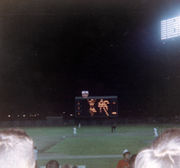
The Expos won their first game, on the afternoon of April 8, 1969, against the New York Mets at Shea Stadium, beating the Mets by a score of 11–10. The Expos took the field for the first time with Bob Bailey playing first base, Gary Sutherland playing second base, Maury Wills playing shortstop, Coco Laboy playing third base, Mack Jones playing left field, Don Hahn playing centerfield, Rusty Staub playing right field, John Bateman at catcher and Mudcat Grant on the mound. The first manager was former Philadelphia Phillies manager Gene Mauch. Wills had the first hit in Expos history and also scored the first run. The first home run in franchise history came from an unlikely source — relief pitcher Dan McGinn. Bailey had the first RBI, and Don Shaw was credited with the win. Carroll Sembera pitched the final inning against the Mets and recorded the first save.
The first game at Jarry Park was played on April 14 — an 8–7 Expos win over the St. Louis Cardinals, broadcast nationwide on CBC television and radio. A crowd of 29,184 jammed every corner of Jarry Park to watch the first major league baseball game ever played outside the United States. Jarry was only intended as a three-year temporary facility until what became Olympic Stadium could be completed, and so the stands were left completely exposed to the elements. As a result, the Expos frequently had to postpone games in April and September because there was no protection for the fans. Another problem was its orientation; first basemen were often blinded by the setting sun, forcing stoppages of play.[14] When it became apparent that Olympic Stadium wouldn't be ready for 1972, the league threatened to yank the franchise. However, the Expos managed to get a reprieve at the 1971 winter meetings. They would get a reprieve at all winter meetings until Olympic Stadium was ready for the 1977 season.
Following that first series in Montreal, the Expos went to Philadelphia to play the Phillies. On April 17, Bill Stoneman pitched the first no-hitter in the club's history, as the Expos won 7–0. Stoneman's feat gave the Expos the record for the earliest no-hitter recorded by any major league baseball franchise — only ten days after their very first game.
Rusty Staub and Mack Jones would become the darlings of the Montreal fans during the early years of the team. Staub was affectionately known as "Le Grand Orange" (in tribute to his red hair), and with Jones playing left field for the team, the left field bleachers at Jarry Park came to be known as "Jonesville."
Staub was traded in 1972 to the New York Mets in exchange for 3 young prospects: first baseman-outfielder Mike Jorgensen, infielder Tim Foli, and outfielder Ken Singleton. While the trade landed Montreal three youngsters that would help the still maturing expansion team, many Montrealers were saddened to lose a popular player. Staub was reacquired by Montreal in July 1979. At his first game back in Montreal, against the Pittsburgh Pirates, Staub received a long and heartfelt standing ovation from the adoring fans, welcoming "Le Grand Orange" back. Staub left the team for good after the 1979 season. His number 10 was eventually the first one retired by the Expos.
After 10 straight losing seasons under Mauch (1969–75), Karl Kuehl and Charlie Fox (1976) and Dick Williams (1977–78), in 1979 under Williams the Expos posted a 95–65 record — the first of five consecutive winning seasons, and their best record for any complete season in Montreal franchise history — and finished in second place in the NL East.
Promise of the 1980s
The Expos made their only postseason appearance in Montreal franchise history during the split season of 1981. In the 1981 playoffs, the Expos defeated the Philadelphia Phillies 3–2 in the divisional series, but lost to the Los Angeles Dodgers 3–2 in the National League Championship Series, on a game postponed from Sunday to Monday afternoon due to rain. The difference in the game was a ninth inning home run by Dodger Rick Monday. The game has since been referred to as Blue Monday.
Montreal was led through the 1980s by a core group of young players, including catcher Gary Carter, outfielders Tim Raines and Andre Dawson, third baseman Tim Wallach and pitchers Steve Rogers and Bill Gullickson. The promising aspects of the Expos gave rise to the name "Team of the 80s".[15] Attendance at Olympic Stadium went up each year from 1979 to 1983 (excluding the strike year in 1981),[16] and the fans would express their excitement in song — the "The Happy Wanderer" being a fan favourite after offensive explosions.[17]
In spite of the team's talent, the Expos were unable to finish above third place from 1982 to 1991. They had up-and-down years, with a winning percentage of .484 in 1984 under managers Bill Virdon and Jim Fanning and 1986 under Buck Rodgers, but above .500 seasons in 1985, 1987, and 1990 under Rodgers.
Gary Carter was traded to the New York Mets in December 1984 for Hubie Brooks, Mike Fitzgerald, Herm Winningham, and Floyd Youmans.[18] Andre Dawson left as a free agent after the 1986 season.[19]
Under new ownership
In the 1989 season, with the Expos vying for a post-season berth, the team traded Gene Harris, Brian Holman, and Randy Johnson to Seattle for Mark Langston.[20] Langston completed the season for the Expos with a 2.39 ERA (tied for the league lead in ERA+ with a 148 rating) and a league-leading 8.9 strikeouts per nine innings.[21] Though the Expos led the National League East from the end of June to the start of August, and were two games behind first on September 6, they fell back to finish in fourth with a .500 record.[22] Langston, Hubie Brooks, Pascual Pérez, and Bryn Smith left after the season as free agents. Following a winter of rumours, at the start of the 1990 spring training season, owner Charles Bronfman formally announced his intentions to sell the Expos, saying "After 21 years in baseball it's emotionally very draining. ... After a while, you're just burned out."[23] In November, at the press conference where the sale of the franchise to a local consortium was announced, Bronfman said that 1989 "... was the year we should have won. ... It was a very bitter disappointment."[24] Claude Brochu, the team's President and Chief Operating Officer since September 1986, became the managing general partner of the Expos, representing a consortium of 14 owners, which also included BCE, Canadian Pacific, the City of Montreal, Nesbitt Burns, and Univa (Provigo).[3][25] The official transfer of ownership occurred on June 14, 1991.
With a new ownership group in place, the Expos traded Tim Raines to the Chicago White Sox in a five-player deal that brought Iván Calderón to Montreal.[26] Starting the 1991 season with a 20–29 record,[27] General manager David Dombrowski (who had inherited manager Buck Rodgers upon assuming the GM position in 1988)[28] fired Rodgers and replaced him with Tom Runnells, who completed the season with a record of 51–61 for an overall winning percentage of .441.[29] Runnells switched third baseman Tim Wallach to first base, a move unpopular with the Montreal fans. The most notable highlight of 1991 was the perfect game thrown by Expos pitcher Dennis Martinez against the Los Angeles Dodgers on July 28, 1991. Dombrowski left Montreal in September to become the General Manager for the Florida Marlins expansion franchise,[30] and Dan Duquette became the Expos general manager.[28]
At spring training in 1992, Runnells held a meeting while dressed in combat fatigues, giving the team's pre-season training the appearance of a boot camp. The team failed to respond to Runnells's attempt at humor, and Runnells was fired on May 22, with a 17–20 record.[31] Felipe Alou, a long time member of the Expos organization since 1976, was promoted from bench coach to field manager, becoming the first Dominican-born manager in MLB history. Alou promptly returned Wallach to the third base position. Alou led the team to a 70–55 record, for an overall winning percentage of .537.[3] Under Alou, Montreal had winning records from 1992 to 1996, with the exception of 1995. The Expos finished second in the National League East in 1992 and 1993.[16]
Dan Duquette left the Montreal Expos in January 1994 for his dream job, General Manager of the Boston Red Sox. Kevin Malone, the Expos director of scouting, took over as Montreal's GM.[32]
Hope and disappointment in 1994
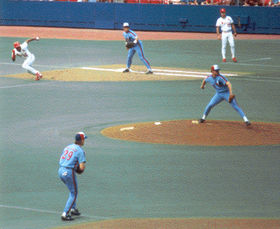
The year 1994 proved to be heartbreaking for the Expos. The team's key contributors included outfielders Larry Walker, Moisés Alou, Marquis Grissom, and Rondell White; infielders Wil Cordero and Sean Berry; starting pitchers Ken Hill, Pedro Martinez, and Jeff Fassero; and the relief corps of Jeff Shaw, Gil Heredia, Tim Scott, Mel Rojas and John Wetteland.[33]
The Expos had the best record in Major League Baseball, 74–40, when the start of a players' strike on August 12, 1994 brought the season to a premature close and resulted in the cancellation of the World Series. The team was six games ahead of the second place Atlanta Braves and on pace to win 105 games. The strike damaged the Expos' campaign for a new stadium, and the local ownership group chose not to invest additional funds to retain the team's best players.
Final decade
During the 1994–1995 offseason, Claude Brochu instructed general manager Kevin Malone to conduct a fire sale and cut ties with the team's major stars. Larry Walker left as a free agent, and as the Expos had not offered him salary arbitration, they did not receive any compensation for Walker's departure. John Wetteland was traded to the New York Yankees, Ken Hill to the St. Louis Cardinals, and Marquis Grissom to the Atlanta Braves.[3] The Expos' attendance flatlined after the fire sale and never recovered; their average attendance would never top 20,000 again during their last 10 seasons in Montreal.
Kevin Malone resigned as general manager in October 1995, saying "I'm in the building business, not in the dismantling business."[34] Moisés Alou and Mel Rojas left as free agents after the 1996 season,[1] and Pedro Martínez was traded after the 1997 season, shortly after winning the Cy Young Award.[35]
The Expos had losing seasons until 2002, except for 1996, when the team finished second with a .543 winning percentage. In 2002 and 2003, the team finished with identical .512 records. After losing superstar Vladimir Guerrero to free agency, the Expos finished 2004, the team's final year in Montreal, with a 67–95 record.
In 1998, the Régie des installations Olympiques replaced Olympic Stadium's orange retractable roof with a permanent blue roof.[36] The retractable roof was removed after the Expos homestand ending on May 10, and on May 21, the Expos played their first outdoor home game since September 8, 1991.[37] During this time when Olympic Stadium was once again an open-air park, Rondell White became the only person to hit a ball out of Olympic Stadium, driving a foul ball out of the third-base side of the stadium in a game against the New York Yankees.[38]
Purchase by Jeffrey Loria
On December 9, 1999, American art dealer Jeffrey Loria became the Expos' chairman, CEO, and managing general partner, purchasing Claude Brochu's ownership stake, and naming his stepson, David Samson, executive vice-president.[4][5] Loria made his initial splash by signing Graeme Lloyd for $3,000,000,[39] and acquiring Hideki Irabu's $4,125,000 contract[40] and Lee Stevens's $3,500,000 contract[41] in trades.[4] The total sum of these contracts was nearly 50% of the 1999 payroll.[42]
Loria subsequently lost a considerable amount of goodwill by failing to sign television and English radio broadcast contracts for the 2000 season, as the team tried to increase their revenue from the broadcast rights.[43]
During the 2000 season, Loria requested additional public funding for the planned new ballpark in downtown Montreal, Labatt Park. However, the municipal and provincial governments vetoed public funding; Quebec Premier Lucien Bouchard said that he couldn't in good conscience allow public funding for a new stadium when the province was being forced to close hospitals. In addition, Olympic Stadium still had not been paid for (and wouldn't be paid for until 2006). As a result, the plans for the proposed downtown ballpark were cancelled.[43]
Attendance in the 2001 season dropped to fewer than 10,000 per game (lower than some minor-league teams), raising questions about the franchise's viability in Montreal. Felipe Alou was fired at the end of May,[44] ending his Montreal managerial career with a total of 691 wins, the most of any manager in the franchise's history.[45] On November 6, 2001, MLB's owners voted 28–2 to contract MLB by two teams — according to various sources, the Expos and the Minnesota Twins, both of which reportedly voted against contraction.[6]
Purchase by Major League Baseball
On December 20, 2001, the Boston Red Sox were sold to a partnership led by John W. Henry, the owner of the Florida Marlins. The purchase was approved by the MLB owners in January.[6][7] (Henry had been able to purchase the Marlins without an open bidding process on his promise to self-finance a new stadium in South Florida. However, he had backed out of his promise almost as soon as his ownership deal was secure, and was looking to either have a publicly-financed stadium built for him or to sell or move the team. ) To clear the way for Henry's group to formally take control of the Red Sox, Henry sold the Marlins to Loria, in a deal approved by MLB on February 1, 2002. The Major League Baseball owners voted 30–0 to form a Delaware partnership, Expos Baseball, LP, to buy the Expos for US$120 million from Loria,[6] an apparent first step to eliminate the franchise. After both deals closed, Loria moved the entire Expos management and coaching staff, including manager Jeff Torborg, to Miami — leaving the Expos without personnel, scouting reports, and office equipment, including the team's computers. Without a viable owner willing to operate the team in Montreal, it appeared that the Expos would either be disbanded or moved.
However, the Metropolitan Sports Facilities Commission, operator of the Metrodome, won an injunction requiring the Twins to play there in 2002.[6] Without a second team to join them in oblivion, the loss of the Expos would have left MLB with an odd number of teams, thus requiring one team to be idle every day. With this constraint, it would have been logistically impossible to preserve a 162-game schedule within MLB's six-month season. As MLB could not find a suitable new home for the Expos at that late date, and was not willing to alter the schedule, it was forced to keep the Expos in Montreal for the short term. MLB named former Anaheim Angels president Tony Tavares team president, Mets assistant general manager Omar Minaya vice-president and general manager, and MLB's chief disciplinarian Frank Robinson manager. MLB also leased a new FieldTurf surface for one year to replace Olympic Stadium's aging AstroTurf, with an option for a second year — a sign that it did not intend to keep the Expos in Montreal.[46] In August, the contraction issue was postponed further, as MLB signed a collective bargaining agreement with the players association that prohibited contraction through the end of the agreement in 2006.[8]
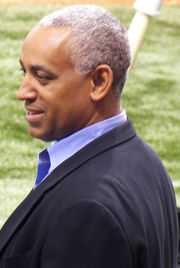
With the Expos four games above .500 in late June and no clearly-defined guidance from MLB on the team's future other than a hard limit on payroll, in an attempt to capitalize on one last chance to bring a championship to Montreal, Minaya made what is regarded by many as one of the most one-sided trades in MLB history when he acquired pitcher Bartolo Colón from the Cleveland Indians in exchange for future All-Stars Brandon Phillips and Grady Sizemore as well as 2008's AL Cy Young award winner Cliff Lee. The gambit did not result in a post-season berth for the Expos, and Colón was traded to the Chicago White Sox during the off-season.
Although their attendance increased from 7,935 per game in 2001[47] to 10,031 in 2002,[45] MLB decided that the Expos would play 22 of their home games at Hiram Bithorn Stadium in San Juan, Puerto Rico in 2003. Despite being a considerably smaller facility (it seats approximately 19,000) than Montreal's Olympic Stadium, attendance in San Juan's Hiram Bithorn Stadium averaged 14,222, compared with 12,081 in Montreal.[16] The Puerto Rican baseball fans embraced "Los Expos" (particularly Puerto Rican players Jose Vidro, Javier Vazquez and Wil Cordero, and other Latin players like Vladimir Guerrero and Liván Hernández) as their home team (as well as the Latin players from other teams), all the while hoping the team would make a permanent move to Puerto Rico. Thanks in part to the San Juan games, the Expos were able to draw over a million fans at home in 2003 for the first time since 1997.[16] The Expos' season in Puerto Rico was chronicled in the MLB-produced DVD Boricua Beisbol — Passion of Puerto Rico.
Led by Vladimir Guerrero, the 2003 Expos were part of a spirited seven-team Wild Card hunt. On August 28, they found themselves in a five-way tie for the lead with Philadelphia, Florida, St. Louis, and Houston. However, MLB, led by Bud Selig, in what ESPN's Peter Gammons called "a conflict of interest," decided that it could not afford an extra $50,000 to call up players from its minor leagues to take advantage of MLB's expanded roster limit during September. The budget was some $35 million. This doomed any hopes of reviving the franchise. Minaya later said, "Baseball handed down a decree.” They would not be allowed to call up players from the minors on September 1, as it was deemed too expensive. They would have to make do with what they had. "It was a message to the players," Minaya said. "It was a momentum killer." He also stated: "They're a tough group of guys. You cannot ever forget 2003; they were as good as the Marlins, who won the World Series. But nobody knows this because nobody saw Montreal in 2003. What killed us was not getting the call-ups."[48] This restriction was later cited by shortstop Orlando Cabrera as the reason he wanted to leave the team (he would be traded away in July, 2004).[49]
The Expos had a 12–15 record from August 29 to the end of the season,[50] finishing eight games out of the wild card race.[51]

Final season
The Players' Union initially rejected continuing the San Juan arrangement for the 2004 season, but later relented. Meanwhile, MLB actively looked for a relocation site. Some of the choices included Washington, D.C.; San Juan; Monterrey, Mexico; Portland, Oregon; New Jersey; Northern Virginia; and Norfolk, Virginia. During the decision-making process, Selig added Las Vegas, Nevada, to the list of potential Expos homes.
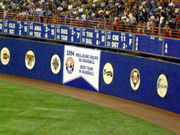
On September 29, 2004, MLB officially announced that the Expos franchise would move to Washington, D.C. for 2005. Later that night, the Expos played their last game in Montreal, a 9–1 loss to the Florida Marlins before a season-high crowd of 31,395 fans.[9] Although the team had worried about fan reaction, there were only a couple of incidents with objects thrown on the field.[9] To commemorate their unfinished 1994 season, the Expos unfurled a banner reading "1994 Meilleure Équipe du Baseball / Best Team in Baseball." The fans gave standing ovations to team stars Tony Batista, Brad Wilkerson, and Liván Hernández, and applauded loudly up until the final out. After the game, thanks were given to the crowd by Claude Raymond in French, Jamey Carroll in English, and Hernandez in Spanish.[9][52]
The end of the legal fight to keep the Expos in Montreal came on November 15, when arbitrators struck down a lawsuit by the former team owners against MLB and former majority owner Jeffrey Loria. The MLB franchise owners approved the move to Washington in a 28–1 vote on December 3. Baltimore Orioles owner Peter Angelos cast the sole "nay" vote, resenting the franchise's relocation and intrusion into the Baltimore/D.C. market.
The Expos played their final game on October 3, 2004 at Shea Stadium, losing by a score of 8–1 to the New York Mets, the same franchise that the team had first faced, 35 years earlier.
After the move
The Washington Nationals organization sold the rights to Youppi, the Expos mascot, to the Montreal Canadiens hockey team. Olympic Stadium plays host to the occasional concert, Canadian football or soccer game. Its construction bonds were finally paid off in November 2006, a full two years after the Expos' departure.
Historic games
1960s
- April 14, 1969 - Mack Jones hit a three-run home run and two-run triple that highlighted an 8–7 win over the St. Louis Cardinals in the Expos' first home victory as a franchise at Jarry Park. Jones' blast was also the first MLB home run hit outside the United States.
- April 17, 1969 - In just the franchise's ninth game in existence, Bill Stoneman pitched a 7–0 no-hitter while striking out eight batters against the Philadelphia Phillies at Connie Mack Stadium. Johnny Briggs made the final out for the Phillies. Rusty Staub, "Le Grand Orange," was the hitting hero for the Expos, going 4-for-5 with three doubles and a homer.
- August 24, 1969 - In a 6-4 loss to the San Francisco Giants, Willie McCovey hit a 2 run HR off Bill Stoneman in the 4th inning that cleared the scoreboard in right field at Jarry Park and landed in the swimming pool outside of the stadium. Juan Marichal pitched a complete game and Bobby Bonds also homered as the Expos fell to 39-89.
1970s

- October 2, 1972 - Bill Stoneman pitched his second career no-hitter (the final score of this one was also 7–0) in the first game of a doubleheader against the New York Mets, at Jarry Park. The no-hitter was the first ever pitched outside the United States. Future broadcaster Tim McCarver was Stoneman's catcher.
- September 26, 1976 - In the final home game at Jarry Park, the Expos dropped a rain-shortened contest to the Philadelphia Phillies 2-1. Ironically, rain outs were one of the reasons the domed Olympic Stadium was an attraction for the club, although the roof would not be installed for a couple of seasons.
- April 15, 1977 - The Expos set a team attendance record for a regular season game, as 57,592 fans attended the first game at Olympic Stadium. They were defeated 7–2 by the Phillies. Greg Luzinski of the Phillies and Ellis Valentine of the Expos hit homers in the second inning, the first home runs at the Expos' new home.
- July 30, 1978 - The Expos set a team record (which was never broken) for hits in a game when they picked up 28, as they beat the Atlanta Braves by a score of 19–0. Andre Dawson, Larry Parrish and Gary Carter led the way with four hits each.
- September 17-18, 1979 - For this two game home series on a Monday & Tuesday night the Expos drew 54,609 & 56,976 fans respectively vs the Pittsburgh Pirates. This was during the AL East pennant chase. The Pirates won 2-1 & 5-3.
1980s
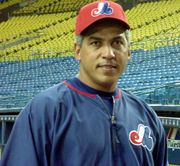
- May 10, 1981 - Charlie Lea pitched a no-hitter against the San Francisco Giants, defeating them 4–0 at Olympic Stadium. The last out was recorded by Andre Dawson, in center field.
- October 11, 1981 - Steve Rogers defeated Steve Carlton, of the Philadelphia Phillies, 3–0 in a pitchers' duel to win the National League Division Series. It was the only postseason series victory in Expos history. Rogers drove in two of the three Expos runs as well, singling home Larry Parrish and Chris Speier in the fifth inning. The Expos advanced to play the Los Angeles Dodgers, who defeated the Astros. Rogers had previously defeated Carlton in Game One of the series as well.
- October 19, 1981 - Blue Monday. In the decisive Game 5 of their only National League Championship Series, the Expos were defeated at home 2–1 by the Los Angeles Dodgers. Tim Raines opened the bottom of the first with a double against Cy Young Award-winning rookie sensation Fernando Valenzuela and scored on an Andre Dawson double play ball. Valenzuela held the Expos scoreless the rest of the way, however, and the Dodgers tied the game at 1 in the top of the fifth with two hits, a wild pitch and an RBI ground-out off Expo starter Ray Burris. The teams remained tied until the top of the ninth, when Expo manager Jim Fanning made a risky decision to relieve Burris with Game 3 winner Steve Rogers. Struggling closer Jeff Reardon was throwing alongside Rogers in the bullpen at the time, but Fanning elected to summon his ace. Rogers retired Steve Garvey and Ron Cey in order, but outfielder Rick Monday homered to put Los Angeles ahead 2–1, crushing the Expos' hopes of advancing to the World Series. Two-out walks from Gary Carter and Larry Parrish were all the Expos could muster in the bottom of the ninth, as Bob Welch preserved the one-run Dodger victory. The Expos lost the NLCS 3 games to 2. They never returned to the postseason.
- July 13, 1982 - The All-Star Game moved across the border, when it was played at Montreal's Olympic Stadium. It was the first Midsummer Classic ever to be held outside of the United States. The National League won 4–1 before a crowd of 59,057. Steve Rogers was the winning pitcher and Dennis Eckersley took the loss. Dave Concepción was named MVP. Five players represented the Expos on the National League squad: Gary Carter, Andre Dawson, Tim Raines, Al Oliver and Rogers.
- April 13, 1984 - In his only season with the Expos, Pete Rose collected his 4,000th hit at Olympic Stadium. The hit placed him alongside Ty Cobb, the only other player with at least 4,000 hits.
- May 2, 1987 - Tim Raines powers the Expos past the New York Mets, going 4 for 5, hitting the first competitive pitch he faced in 1987 for a triple, and hitting a game-winning grand slam in the 10th inning.[53][54] A free agent since November 1986, Raines had just signed with the Expos on the previous day, having missed spring training and the first month of the season as no team made a serious bid to sign him.[55]
- August 23, 1989 - The Expos and Dodgers engaged in a 22-inning marathon, the longest game in Expos history. It eventually ended when Rick Dempsey homered for the Dodgers in the top half of the 22nd inning off Dennis Martinez, who was making a very rare relief appearance. Rex Hudler got caught while attempting to steal second base in the bottom half of the 22nd, ending the game. The game could have ended earlier when a sacrifice fly led to an Expos run, but the Dodgers appealed that the runner left the base too soon. The appeal was recognized by the third base umpire and the third out was recorded. This game also marked the first time a mascot was ejected by an umpire. Youppi!, dressed in a nightgown and nightcap on top of the Dodgers dugout roof, took a running leap, landed hard and noisily, and then snuck into a front-row seat. Dodgers manager Tommy Lasorda demanded that Youppi! be run from the game. Youppi! would later return, but he stayed on the home team's dugout roof. In the end, the game took over six hours to finish and ended close to 2:00 a.m.
1990s
- July 26, 1991 - Mark Gardner pitched 9 innings of no-hit baseball against the Los Angeles Dodgers at Dodger Stadium. It was scoreless going into the tenth when utility man Lenny Harris singled for the Dodgers, breaking up the no-hitter.
- July 28, 1991 - In a 2–0 victory, Dennis Martínez pitched a perfect game against the Los Angeles Dodgers at Dodger Stadium. The final out was recorded by Marquis Grissom in centre field, on a lazy fly ball from the bat of Chris Gwynn.
- September 8, 1991 - Dennis Martinez defeated the Cincinnati Reds 4-2 to lift the Expos to 58-77 on the season before 12,272 fans. A large section of concrete fell off the stadium after this game & before the next home stand was to begin. The balance of the home games were played on the road that year and that, combined with a poor record, and the sale of the team to new owners, contributed to some of the attendance problems leading up to the team's resurgence in 1993 & 1994.
- September 17, 1993 - One of the most exciting pennant races in team history began, as the Expos (85 wins, 62 losses) played their final series of the season against their division rivals, the Philadelphia Phillies (89 wins, 58 losses). The Expos rallied to take an 8–7 victory in front of 45,757 fans at Olympic Stadium. The clutch hitting hero was a hearing disabled rookie named Curtis Pride, who, in his first major league at-bat, doubled home two runners and scored on the following play. After the game, Pride said he couldn't hear the ovation but could feel the vibration of the 45,757 Expos fans. Marquis Grissom won the game by doubling off of Mitch Williams, stealing third, and then scoring on a shallow sacrifice pop fly to center. The Expos would finish the season 94–68, but three games out of first place.
- June 3, 1995 - Pedro Martínez pitched nine perfect innings against the San Diego Padres before giving up a hit in the tenth to Bip Roberts, over the head of Tony Tarasco in centre field. He became the second pitcher in history (the other was Harvey Haddix) to have a perfect game broken up in extra innings. However, the Expos managed to win the game, 1–0.
- May 7, 1997 - The Expos set a team record (which was never broken) for runs scored in one inning, as they scored 13 runs off Julian Tavarez, Jim Poole, and Joe Roa of the San Francisco Giants at 3Com Park. The Expos went on to defeat the Giants 19–3. The only non-pitcher on the Expos not to register a hit was Sherman Obando, who went 0-for-1. A young Vladimir Guerrero hit his first career double and was struck by a pitch for the second time in his career. A crowd of 9,958 was on hand to witness it in San Francisco.
- September 27, 1998 - Mark McGwire faced off against the Montreal Expos in the final game of the season. McGwire finished the season with 70 home runs, hitting his last five in a three-game series against Montreal. In the third inning, McGwire hit a home run off of Mike Thurman, and in the seventh inning he got number 70 off Carl Pavano.
- July 18, 1999 - David Cone, of the New York Yankees, pitched a perfect game against the Expos, winning 6–0. It was the first no-hitter thrown in regular season interleague play.
- August 6, 1999 - Tony Gwynn, of the San Diego Padres, recorded the 3000th hit of his career at Olympic Stadium.
2000s
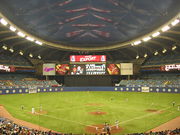
- August 26, 2003 - The Expos rallied twice to claim a 14–10 win against the Philadelphia Phillies and put themselves within two games of the National League Wild Card playoff spot. It was the second-biggest comeback in Expos history.
- September 29, 2004 - Hours after the announcement of the impending move to Washington, D.C., the Expos played their final game in Montreal, a 9–1 loss to the Florida Marlins before 31,395 fans at Olympic Stadium.
- October 2, 2004 - The Expos earned their last win in franchise history, defeating the New York Mets 6–3. Brad Wilkerson hit the last home run in Expos history in the ninth inning, his 32nd of the year.
- October 3, 2004 - The New York Mets defeated Montreal 8–1 at Shea Stadium, in the final game of the franchise's existence as the Montreal Expos. Jamey Carroll scored the last Expos run and Endy Chávez became the final Expo batter in history when he grounded out in the top of the ninth to end the game. (Coincidentally, Shea Stadium was where the Expos had played their first-ever game, in 1969.)
Longest home runs
Willie Stargell hit the longest home run at Olympic Stadium on May 20, 1978, driving the ball into the second deck in right field for an estimated distance of 535 feet. A yellow seat now marks the location where the ball landed.[16] Stargell also hit a notable home run at the Expos' original Montreal home, Jarry Park, which landed in a swimming pool beyond the right field fence.[56]
On April 4, 1988, the Expos' Opening Day, Darryl Strawberry hit a ball off a speaker which hangs off a concrete ring at Olympic Stadium, estimated to have traveled 525 feet.[16]
"Oh Henry" Rodriguez hit a ball on June 15, 1997, that bounced off the concrete ring in right field, caromed up to hit the roof, and came down, hitting a speaker. The distance traveled by this ball is also estimated at 525 feet.[16]
The longest home run hit to left field was Vladimir Guerrero's blast on July 28, 2003, that hit an advertising sign directly below the left field upper deck. The ad was later replaced with a sign reading "VLAD 502".[16]
No-hitters
The first no-hitter in Expos history was pitched by Bill Stoneman during its ninth game, on April 17, 1969, winning 7–0 against the Philadelphia Phillies and striking out eight batters. The team's second no-hitter was another 7–0 victory thrown by Stoneman in the first game of an October 2, 1972, doubleheader at Jarry Park, against the New York Mets.
The Expos' third no-hitter came from Charlie Lea on May 10, 1981, against the San Francisco Giants. The fourth and final no-hitter in the history of the Montreal franchise was a perfect game by Dennis Martínez on July 28, 1991, against the Los Angeles Dodgers at Dodger Stadium. Expos broadcaster Dave Van Horne, called the final out on the telecast: "In the air...center field...El Presidente, El Perfecto!" Martinez's perfect game was the thirteenth in Major League Baseball history.
Two other no-hit games were pitched in shortened games. David Palmer won 4–0 on April 21, 1984 in 5 innings during the second game of a doubleheader vs. the St. Louis Cardinals. Pascual Pérez beat the Philadelphia Phillies 1–0 in a 5-inning game on Sept. 24th, 1988.
Baseball Hall of Famers
- 8 Gary Carter, C, 1974–84 & 1992. Gary Carter is the first member of the Baseball Hall of Fame who is depicted with an Expos cap on his Hall of Fame plaque.
- 10 Andre Dawson, RF/CF, 1976–86. Dawson was the second member of the Hall of Fame with an Expos cap on his plaque when he was inducted on July 25, 2010.[57]
- 24 Tony Perez, 1B, 1977–79
- 20 Frank Robinson, Manager, 2002–04. Frank Robinson was elected by the Baseball Writers' Association of America (BBWAA) in 1982. On October 4, 1974, Robinson became Major League Baseball's first African-American manager when he assumed the reins of the Cleveland Indians,[47] and he was the first African-American to manage in both the American and National Leagues.
- Dick Williams, Manager, 1977–81
Retired numbers

The Montreal Expos have retired four numbers in honour of five players, including Jackie Robinson's number 42 which was retired throughout baseball in 1997.
On August 14, 1993, on the twenty-fifth anniversary of his first payment to the National League for the Montreal expansion franchise, Charles Bronfman was inducted to the Expos Hall of Fame as its inaugural member. In a pre-game ceremony, a circular patch on the right field wall was unveiled, with Bronfman's name, the number 83, which he used to wear during spring training, and the words "FONDATEUR / FOUNDER".[58]
When the franchise moved in 2004, other than #42, the Washington Nationals returned the numbers retired by the Expos to service and assigned them to new players. On October 18, 2005, the Montreal Canadiens honoured the departed team by raising an Expos commemorative banner, listing the retired numbers, to the rafters of the Bell Centre.
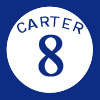 Gary Carter C 1974–84 & 1992 |
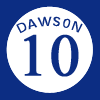 Andre Dawson RF/CF 1977–86 |
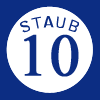 Rusty Staub OF 1969–71 & 1979 |
 Tim Raines LF 1979–90 & 2001 |
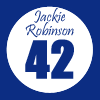 Jackie Robinson 2B Retired 1997 |
Broadcasters
See also
- Montreal Expos all-time roster
- Montreal Expos seasons
- Pearson Cup
- Expos managers and ownership
- Active MLB non-playoff appearance streaks
- The Cap
References
- ↑ 1.0 1.1 Montreal Expos (1997). Expos Media Guide 1997.
- ↑ Carpenter, Les (2005-04-16). "Alas, Youppi! Unable To Shout 'Yippee!'". The Washington Post. http://www.washingtonpost.com/ac2/wp-dyn/A57552-2005Apr15?language=printer. Retrieved 2008-05-11.
- ↑ 3.0 3.1 3.2 3.3 3.4 Montreal Expos (1996). Expos Media Guide 1996.
- ↑ 4.0 4.1 4.2 Montreal Expos (2000). Expos Media Guide 2000.
- ↑ 5.0 5.1 Blair, Jeff (1999-12-10). "Expos to field better team, Loria says Ebullient new chairman vows to increase salary limit, build new ballpark for 2002 season". The Globe and Mail (The Globe and Mail): pp. S.1.
- ↑ 6.0 6.1 6.2 6.3 6.4 6.5 6.6 6.7 Schoenfield, David (2002-02-05). "Still 30 teams: Contraction timeline". ESPN.com. http://assets.espn.go.com/mlb/s/2002/0205/1323230.html. Retrieved 2009-02-19.
- ↑ 7.0 7.1 Mnookin, Seth (2006). Feeding the Monster. How Money, Smarts, and Nerve Took a Team to the Top.. New York, New York: Simon & Schuster. ISBN 0-7432-8681-2.
- ↑ 8.0 8.1 MLB.com (2002-08-30). "Deal in place, games go on". Press release. http://mlb.mlb.com/NASApp/mlb/mlb/news/mlb_news.jsp?ymd=20020830&content_id=116907&vkey=news_mlb&fext=.jsp. Retrieved 2006-12-28.
- ↑ 9.0 9.1 9.2 9.3 Myles, Stephanie (2004-09-30). "31,395 say goodbye". Montreal Gazette: pp. C1
- ↑ "Key dates in Expos history". Canadian Broadcasting Corporation. 2004-09-29. http://www.cbc.ca/sports/indepth/expos/timeline.html. Retrieved 2008-02-24.
- ↑ "History of the Expos at the Major League Baseball Official website". http://montreal.expos.mlb.com/NASApp/mlb/mon/history/mon_history_feature.jsp?story=1. Retrieved 2006-11-04.
- ↑ "Washington Nationals". Baseball Almanac Online. http://www.baseball-almanac.com/teams/washington_nationals.shtml.
- ↑ Chipello, Christopher J. (2005-06-03). "Expos' move marks end of baseball era in French". Wall Street Journal (Post-Gazette NOW Sports). http://www.post-gazette.com/pg/05154/515468.stm. Retrieved 2008-02-08.
- ↑ Zucco, Tom (1980-08-08). "Baseball's history reveals plenty of freak happenings". St. Petersburg Times (St. Petersburg, Florida): p. 4. http://news.google.com/newspapers?nid=888&dat=19800808&id=iQMMAAAAIBAJ&sjid=QloDAAAAIBAJ&pg=4972,6751453. Retrieved 2009-05-28.
- ↑ MacDonald, Ian (2008-01-18). "Expos patriarch McHale at age 86". Montreal Gazette. http://www.canada.com/montrealgazette/news/sports/story.html?id=c017d094-4811-4a1a-9e7d-7ed990846adb&k=43885. Retrieved 2008-01-19.
- ↑ 16.0 16.1 16.2 16.3 16.4 16.5 16.6 16.7 Montreal Expos (2004). Expos Media Guide 2004.
- ↑ The Sports Network. "Au Revoir Expos: Farewell to Montreal". TSN.ca. http://www.tsn.ca/mlb/feature/?fid=9973. Retrieved 2007-09-01.
- ↑ Sports Reference, Inc. (2007). "Gary Carter statistics". http://www.baseball-reference.com/c/cartega01.shtml. Retrieved 2007-10-29.
- ↑ Sports Reference, Inc. (2007). "Andre Dawson statistics". http://www.baseball-reference.com/d/dawsoan01.shtml. Retrieved 2007-10-29.
- ↑ Montreal Expos (1990). Expos Media Guide 1990.
- ↑ Sports Reference LLC (2009). "1989 National League Standard Pitching". Baseball-Reference.com. http://www.baseball-reference.com/leagues/NL/1989-standard-pitching.shtml. Retrieved 2009-04-11.
- ↑ Falvey, Christopher J.. "Live MLB Baseball pennant races, scores, standings, stats, graphs, charts throughout Major League history". http://www.baseballrace.com/races/MLB-1989-NL_East-Normal.asp. Retrieved 2009-04-11.
- ↑ Campbell, Neil A. (1990-03-23). "Bronfman drained from exercise of owning Expos". Globe and Mail: pp. A.17
- ↑ Farber, Michael (1990-11-30). "Bronfman was perfect owner - a fan; English Montreal gently gives way to French Montreal, again". Montreal Gazette: pp. F.1
- ↑ Blair, Jeff (1991-06-15). "Brochu group goes to bat for baseball survival here; Expos sale official as Bronfman era ends". Montreal Gazette: pp. C.1
- ↑ Sports Reference, Inc. (2007). "Tim Raines statistics". http://www.baseball-reference.com/r/raineti01.shtml. Retrieved 2007-10-29.
- ↑ Baseball-Reference.com. "Buck Rodgers Managerial Record". Baseball-Reference.com. http://www.baseball-reference.com/managers/rodgebu01.shtml. Retrieved 2007-09-01.
- ↑ 28.0 28.1 Baseball America. "Executive Database: Franchise: Washington Nationals". Baseball America. http://www.baseballamerica.com/today/execdb/showteam.php?team=WAS. Retrieved 2007-09-08.
- ↑ Baseball-Reference.com. "Tom Runnells Managerial Record". Baseball-Reference.com. http://www.baseball-reference.com/managers/runneto01.shtml. Retrieved 2007-09-01.
- ↑ MLB Advanced Media. "History: Marlins Timeline". MLB.com. http://florida.marlins.mlb.com/fla/history/timeline2.jsp. Retrieved 2007-09-08.
- ↑ James, Bill (1997). The Bill James guide to baseball managers: from 1870 to today. New York, New York: Scribner. pp. 352. ISBN 0-684-80698-3.
- ↑ The New York Times (1994-01-27). "Duquette to Be Red Sox General Manager". The New York Times. http://query.nytimes.com/gst/fullpage.html?res=9A07E4D61F30F934A15752C0A962958260. Retrieved 2007-09-08.
- ↑ Sports Reference (2008). "1994 Montreal Expos Statistics and Roster". baseball-reference.com. http://www.baseball-reference.com/teams/MON/1994.shtml. Retrieved 2008-10-22.
- ↑ The New York Times (1995-10-03). "Expos' G.M. Decides to Go". The New York Times. http://query.nytimes.com/gst/fullpage.html?res=990CE7D7163AF930A35753C1A963958260. Retrieved 2007-09-08.
- ↑ Montreal Expos (1998). Expos Media Guide 1998.
- ↑ Gouvernement du Québec (2004). "History of the Olympic Park". Gouvernement du Québec. http://www.rio.gouv.qc.ca/pub/parc/historique_po.jsp?locale=en. Retrieved 2007-02-22.
- ↑ New York Times (1998-05-20). "National League: Roundup". New York Times. http://query.nytimes.com/gst/fullpage.html?res=9802E5DB1539F933A15756C0A96E958260&sec=&spon=&partner=permalink&exprod=permalink. Retrieved 2007-02-22.
- ↑ Myles, Stephanie (1998-06-11). "Expos' play gives fans few reasons to cheer : Yankees 6 Expos 2". Montreal Gazette (Montreal Gazette): pp. F.1.
- ↑ "Graeme Lloyd statistics". http://www.baseball-reference.com/l/lloydgr01.shtml. Retrieved 2006-09-29.
- ↑ "Hideki Irabu statistics". http://www.baseball-reference.com/i/irabuhi01.shtml. Retrieved 2006-09-29.
- ↑ "Lee Stevens statistics". http://www.baseball-reference.com/s/stevele01.shtml. Retrieved 2006-09-29.
- ↑ "1999 Montreal Expos". http://www.baseball-reference.com/teams/MON/1999.shtml. Retrieved 2006-09-29.
- ↑ 43.0 43.1 Smith, Curt (2001). Storied Stadiums. New York City: Carroll & Company. ISBN 0786711876.
- ↑ CBC News (2001-05-31). "Alou fired as Expos manager". Canadian Broadcasting Corporation. http://www.cbc.ca/canada/story/2001/05/31/expos010531.html. Retrieved 2009-01-07.
- ↑ 45.0 45.1 Montreal Expos (2003). Expos Media Guide 2003.
- ↑ Pahigaian, Josh; O'Connell, Kevin (2004). The Ultimate Baseball Road Trip. Guilford, Connecticut: Lyons Press. ISBN 1592281591.
- ↑ 47.0 47.1 Montreal Expos (2002). Expos Media Guide 2002.
- ↑ Carpenter, Les (2005-07-04). "Minaya Laid Foundation For Success". The Washington Post. http://www.washingtonpost.com/wp-dyn/content/article/2005/07/03/AR2005070301106.html. Retrieved 2008-05-11.
- ↑ Chass, Murray (2005-06-07). "Nonpartisan Nationals Winning Fans". The New York Times (The New York Times Company). http://www.nytimes.com/2005/06/07/sports/baseball/07chass.html. Retrieved 2008-05-11
- ↑ Sports Reference. "2003 Montreal Expos Schedule, Box Scores, and Splits". baseball-reference.com. http://www.baseball-reference.com/teams/MON/2003_sched.shtml. Retrieved 2008-09-10.
- ↑ Falvey, Christopher J.. "Live MLB Baseball pennant races, scores, standings, stats, graphs, charts throughout Major League history". http://www.baseballrace.com/races/MLB-2003-NL-Wildcard.asp. Retrieved 2008-09-10.
- ↑ Todd, Jack (2004-09-30). "Adieu, Nos Amours". Montreal Gazette: pp. A1
- ↑ Keri, Jonah (2007-12-29). "Raines: 'I played the game with excitement, focus'". ESPN.com. http://sports.espn.go.com/mlb/hof08/news/story?id=3170163. Retrieved 2008-01-19.
- ↑ "Retrosheet Boxscore: Montreal Expos 11, New York Mets 7". Retrosheet.org. http://www.retrosheet.org/boxesetc/1987/B05020NYN1987.htm. Retrieved 2008-01-19.
- ↑ Anderson, Dave (1987-05-05). "SPORTS OF THE TIMES; Nobody Wanted Raines". The New York Times. http://query.nytimes.com/gst/fullpage.html?res=9B0DE2DE1030F936A35756C0A961948260. Retrieved 2008-01-19.
- ↑ Ballpark Digest. "Jarry Park / Montreal Expos / 1969-1976". Ballpark Digest. http://www.ballparkwatch.com/stadiums/past/jarry_park.htm. Retrieved 2007-09-22.
- ↑ Mitchell, Fred (2010-01-27). "Dawson 'disappointed' he won't wear Cubs cap". Chicago Tribune. http://www.chicagobreakingsports.com/2010/01/dawson-disappointed-over-decision-not-to-wear-cubs-cap.html. Retrieved 2010-01-27.
- ↑ Blair, Jeff (1993-08-15). "This used to be his playground; Bronfman was always a fan; Original owner steps into Expos Hall of Fame". Montreal Gazette (Montreal Gazette): pp. D.1.
External links
- La Défense de Montréal - Voros McCracken's notes on the meddling by ownership and Major League Baseball that killed the Expos in Montreal (9 November 2001).
- 1985 Expos - Radio highlights from the 1985 season on AM-600, including "The Heat is On" Expos-mix.
- Encore Baseball Montréal (French and English)- Encore Baseball Montréal is a non-profit organization that aims to be the voice of baseball fans in order to maintain interest in baseball in the province of Quebec
- exposhistory.org - Valderi-Valdera! Les Expos Sont Là! It's Up, Up, & Away! A site dedicated to the history of the Montreal Expos. See every day in Expos history, including scores/box scores, day-to-day standings, transactions and more.
- independent-baseball.com - Montreal Expos tribute section — pictures of Montreal Expos games
- Sports E-Cyclopedia's History of the Expos
- CBC Digital Archives - Major League Baseball Comes to Canada
- SRC - Départ des Expos de Montréal
- Official site of the Washington Nationals
- Montreal Expos Sports Illustrated Website
- Montreal Expos CBS Sportsline Website
- Archives de Montréal - Photo album of the opening game at Jarry Park, April 14th 1969
- Montreal Expos / Washington Nationals Franchise Record at Baseball Reference
| National League Eastern Division Champions | ||
| Preceded by: Philadelphia Phillies |
1981 | Succeeded by: St. Louis Cardinals |
|
||||||||||||||||||||||||||||||||||||||||||||||
|
|||||||||||||||||||||||